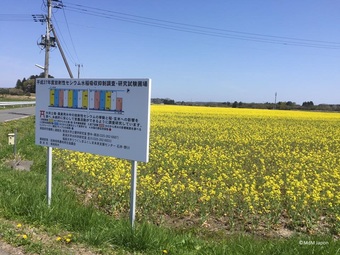The East Japan Great Earthquake : Activity Report No.15 at Fukushima So-So District

This report was written by Yukari Komatsubara about her activity at the Community Hall of Odaka District, Minami Soma City, Fukushima-ken. With the Evacuation Directives due to be lifted very shortly, she works as a practitioner of health-and-sport therapy for the community people.
A part of Minamisoma, within a radius of 20km from the Fukushima No.1 Nuclear Power Plant, remains the no-go-zone (off-limits area), and many residents are still forced to live outside the zone. It was March 2016 that I visited Minamisoma for the first time, which was actually quite recent. What I saw there, first of all, was a number of media teams deluging to cover the 5th anniversary of the Tohoku Earthquake. At the same time, what caught my eye were the trucks at work to remove nuclear pollutants, and a pile of black bags containing radioactive wastes left out in the open air. I was lost for words at the severe reality that five long years were not really long enough to bear fruit but were of little help for recovery.
My first impression of the town was an underpopulated quiet town. Now a few months later, the town has changed more or less regaining life with more houses being built under the Disaster Restauration Housing Plan and with private passenger vehicles increasing more than the construction vehicles. When I go to the district of Odaka where I work, I take a ride with our partner Nagomi’s staff in their car. One sunny day, we came across a field of mustard flowers stretching to the horizon like a sea, so beautiful was the sight that I reflexively clicked my camera. By the edge of the field, in contrast, was a large signboard warning of the risks of radioactive cesium , which would bring me back, whether you like it or not, to the world of stern reality.
“Odaka Platform” is a human networking space implemented to enhance companionship among the community people and thereby to help revitalize their life. It is a mechanism that helps all residents focus their efforts into what each individual can do, in order to rebuild a community where everyone can visualize own clear and concrete future and to make their community a model town of recovery after the evacuation cancelled. I work here once a month as an instructor of “Plat Yoga”, providing massage therapy and teaching stretch exercises to the community residents as well as to non-residents. “Plat” in Japanese phonetics suggests an action or a motion without a “specific motive”, hence the idea is to “welcome everyone regardless of motivation.”
The last time I visited Odaka Platform was just a few days after the Kumamoto-Oita area had been hit by the earthquake of intensity +7. All participants at the meeting expressed great concerns for the afflicted people: “I shudder at the memory of those days, the first few days were really tough because I was not used to the life in an evacuation center,” “I saw many people donating into a collection box at a convenience store. I saw some putting a ten-thousand-yen bill!” “Everybody is willing to repay for the kindness we received five years ago.” Since I joined the mental healthcare program in 2011, this is the first time I have ever seen and heard the local people speak frankly to each other about their past. In fact, all of them seem truly comfortable and natural to tell the bottom of their heart.
“Plat Yoga” aims to relieve mental tension and stress by means of relaxing entire body. If you become physically relaxed, you will be more inclined to speak out your honest feelings, and will come to know what you really need or want. It’s true that time is the best medicine. Five years may have been necessary for them to look back the past objectively and feel comfortable to express themselves freely. Today, I received Nemophila’s seeding from Mr. Hirohata (Platform staff) as a gift on behalf of all the Platform members. “Five blue petals of nemophila may remind you of the blue color of Tsunami waves, but it is our dream to fill the town with nemophila flowers and make Odaka a favorite spot for as many visitors as possible,” said Mr. Hirohata, smiling. Every time I visit Odaka-machi, I am greatly encouraged by their positive attitude and determination. I can hardly wait for the day to come when I take a ride in their car and drive the streets of Odaka along the fields of yellow mustard flowers and blue nemophila.
(Yukari Komatsubara, Practitioner/Instructor of Health & Sport Therapy)
